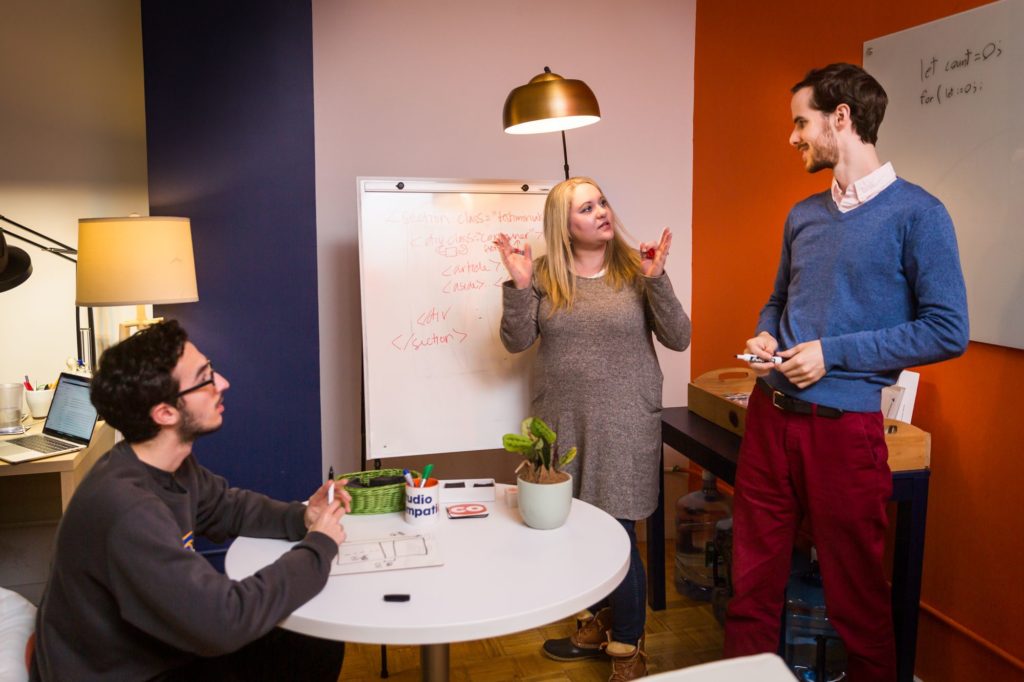What prompted the Studio Simpatico website redesign? What were the key goals and success metrics for the project? At a high level, what were you looking to accomplish with the new site?

Our previous (and first) company website was quickly assembled in the frantic, fun, and fearless two weeks between Sinan’s first day and our launch announcement in February 2017.
To get the job done, we modified a pre-made theme: a smart choice given our short timeframe and (as a web design and development firm) immediate need for a website, but a less-than-stellar one for the long-term given our commitment to exclusively working with custom themes. The months turned into years however, and as client work continued to be the priority, as the studio grew we became increasingly self-conscious about our cobblers’ shoes problem.
This summer, we all agreed it was time. The values Sinan and I articulated back in 2017 had been fully realized: our vision for a studio that practiced creative collaboration with each other and our clients had grown to a team of six, and all team members had been with the company for over a year. I wanted the site to reflect the full team’s capabilities and talents, and give the company a representative canvas to showcase the great work we’d been doing since our inception.
As far as success metrics: our search engine optimization was strong for many high intent keywords we want to capture given the nature of our business, so our best quantitative success metric was going to be whether more of our ideal customers were converting. Our qualitative goal was to create a site with copy and visuals that correctly captures the warm, inviting, collaborative, excitable nature of our studio and team, in hopes that it will allow clients that are truly simpatico with us to self-select as a good match and get in touch.
Tell us about the target audience. Who’s coming to the site? Who are your clients and prospective clients? What content do they care about, and what is your strategy for messaging them effectively?

Sure. I think it makes sense for me to describe our ‘ideal clients’ using a few different criteria.
The first has to do with the type of services they’re seeking, and whether the work they need aligns with our strengths. Obviously, our site needed to contain a portfolio with our body of work. However, it was a conscious decision to ensure this page was filterable by two vectors: industry and service. Oftentimes clients will want to see whether we have experience working within their niche (whether it’s real estate or fintech or nonprofit organizations), as well as see the type of deliverable they need (whether it’s WordPress development, packaging design, UX/UI design).
The second, more nuanced detail has to do with whether we match the personality attributes, team composition, and working style that a client is seeking. Our client Jared Cluff (the CEO of Caliber Fitness) said it best, “Studio Simpatico is a smaller shop, so be ready to roll up your sleeves and collaborate with them. You’re not going to deal with a bunch of different teams; you’re going to be dealing with the principles at the agency, which is something I really enjoyed.” Our small team’s deeply collaborative, respectful style isn’t for everyone, but we find we have great success when we partner with folks who are simpatico with this type of embedded approach.
Despite its small size, Simpatico offers a wide range of services. When working on the IA and organization of the site, how did you approach the challenging task of representing all of these services and niches, while broadly communicating the team’s strengths?

Search drives a fair bit of Simpatico’s new business, and different high-intent keywords drive to our different service pages (for example, someone looking for a WordPress development agency will more than likely first land on our WordPress development service page). Thus, it’s critical that all of these pages serve as a “front door” to the site, explaining not just our value propositions related to that particular service, but also our studio’s ethos.
A trick I love for identifying value propositions for our clients’ products or services is to dig into what happy users or clients have to say. To understand our core differentiators, we consulted our Clutch profile, which features interviews of our clients transcribed by the analysts at Clutch.
What types of low-fidelity deliverables did you create to kickoff the planning and redesign process?

Overall, we were mindful to apply the same tried and true website design and development process to our internal site redesign project as we do with all client projects. Thus, the deliverables were the same as we produce for all of our website design and development redesigns:
- A spreadsheet audit that includes all pages that exist in the current build, with insights pulled from Google Analytics and Google Search Console about traffic and keyword optimization
- Site map (I prefer making them in LucidChart) that provides a bird’s eye view of all the page templates to be included in the new build, including details around the WordPress infrastructure plans (which pages should use a page builder, plans for custom post types, etc.)
- Wireframes (Balsamiq’s my tool of choice) showing the specific information architecture of each page template — our site depends so heavily on copy that I decided to write (mostly) final copy during the wireframing stage so we could fully assess the narrative flow before finalizing UX deliverables and moving on to visual design
How does the team approach content strategy for the blog (“Simpatico Perspectives”)?

One of my responsibilities at Simpatico is managing new business: taking the journey with prospective clients as they determine whether or not Simpatico is the right fit for them (both our skills, and our approach). This process gives me unique insight into what is top of mind for them, their concerns about Simpatico, and frequently asked questions. Writing posts to address these questions or concerns has led to some of our most useful (and well-trafficked) articles, including:
- How to prepare for your Simpatico kickoff
- Why we recommend WP Engine for hosting
- How to setup a Google Maps API key
In the same vein, I am also heavily involved in our creative process and WordPress development. When we solve thorny problems, we are eager to share our discoveries with anyone that might be looking for similar solutions. This includes broad, high level topics like how to make sure sites are ADA compliant or why coding emails is so damn difficult to nitty-gritty code solutions like how to animate a hamburger icon into a plus using CSS or how to create a Word document that has pages with different margins (one of our most trafficked articles to date).




